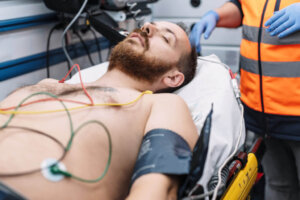The Differences Between a Coma and a Vegetative State

On numerous occasions, we may encounter the terms “coma” and “vegetative state,” yet it’s essential to recognize that they are not interchangeable concepts. These states, while related, are distinctive phases within the spectrum of altered consciousness.
A coma and the vegetative state are part of what are known as alterations of the state of consciousness, but to better understand the differences between them, it’s important to know what consciousness is. A person is conscious when awake and has an adequate understanding of himself and his environment.
Coma: A Profound State of Unconsciousness
The term “coma,” derived from the Greek “koma” meaning ‘deep sleep,’ signifies the most severe stage of altered consciousness.
It’s characterized by a complete and persistent lack of wakefulness and consciousness. Individuals in a coma lie with closed eyes, unresponsive to external stimuli such as vocal commands or pain.
A coma is a transient condition that may progress toward recovery, death, or transition into a vegetative or minimally conscious state.

Vegetative State: Waking Without Consciousness
In contrast, the vegetative state is characterized by the recovery of the waking state, accompanied by a complete loss of conscious content. While individuals in this state may open their eyes, experience regular sleep-wake cycles, and regulate basic physiological functions like heartbeat and breathing, they exhibit no meaningful responses to the environment.
For example, a person who’s in a vegetative state can’t follow an object with their eyes or respond to commands.
In a minority of cases, a vegetative state can develop favorably and regain consciousness. According to the progression, it is classified in the following ways:
- Persistent vegetative state: it lasts for more than four weeks.
- Permanent vegetative state: Maintained for more than six months in cases of non-traumatic brain injury or more than twelve months in the case of a traumatic brain injury.
In the minimally conscious state, the person presents inconsistent events of consciousness. Moments appear when they can communicate or respond to simple commands, such as moving a finger or visually following an object. In some cases, this minimal awareness represents an improvement, but sometimes it remains the same.
What can lead a person to a coma or a vegetative state?
An altered state of consciousness, be it a coma or a vegetative state, can be caused by any process that injures the cerebral hemispheres or subcortical structures. We can differentiate the etiology in different groups.
The primary causes of the central nervous system (CNS)
The injury originates in the brain as a result of the following:
- Head injury
- Stroke
- Intracranial hemorrhages
- Nervous system infections
- Brain tumors
Manifestations that are secondary to a systemic alteration
A coma or a vegetative state can stem from a toxic, metabolic, or endocrine disorder. The following are some of the most common:
- Drug overdose: Such as opioids or benzodiazepines
- Drug abuse: For example, alcohol or cocaine
- Exposure to toxins: Such as carbon monoxide
- Hypoglycemia or hyperglycemia
- Liver failure
- Sepsis
- Hyponatremia or hypernatremia
- Hypothermia
- Hypoxia or hypercapnia
- Panhypopituitarism
- Adrenal insufficiency
- Hypothyroidism or hyperthyroidism
The diagnostic process
After stabilizing the patient, it’s important to gather information from first responders, the family, or witnesses to the event to obtain a suggestive indication of the possible cause that produced the alteration in the patient’s state of consciousness. The doctor will perform a detailed physical exam.
The Glasgow scale is a widely used tool that allows medical professionals to know the level of consciousness that their patient presents. This scale assesses three aspects: Opening of the eyes, verbal response, and motor activity when faced with a stimulus. A score less than 8 indicates that the patient is in a coma.
Based on the physician’s suspicions, initial laboratory tests include glucose, ketones, urea, creatinine, electrolytes, arterial blood gases, and toxicology tests. Imaging studies are done to assess the level of damage to the nervous system.
An EEG should be performed on patients who’ve had seizures.
Coma and vegetative state: Treatment approaches
The treatment of patients in a coma or a vegetative state is based on two fundamental pillars:
- Treating the underlying disease
- Carrying out general care
There are certain causes that are reversible. For example, hypoglycemic coma. On the other hand, when intoxication by certain drugs has occurred, there are some antidotes.
Adequate supportive treatment increases the possibility of eventual spontaneous improvement. This approach includes the following:
- Providing enteral nutrition through a feeding tube.
- Taking the necessary measures to avoid ulcers, mobilizing the patient every 2 hours and using mattresses that prevent bedsores.
- Performing rehabilitation exercises to mobilize the joints and avoid the loss of muscle mass.
- Washing the patient once a day and applying moisturizing creams.
- Inserting a bladder catheter to drain urine.
- Stimulating the patient with music or the voices of their loved ones.
Can a person in a coma or a vegetative state wake up?
It’s impossible to predict when or if a person will wake up from a coma. However, there are factors that can lead to a greater or lesser probability of this happening.
This will depend on the type of brain injury. Injuries resulting from head trauma generally have a better prognosis.
The age of the person also plays a role. Younger patients have a more favorable prognosis. In the same way, the prognosis is considered different according to the amount of time the person has been in this state of altered consciousness.
Some patients gradually improve, while others may remain in a vegetative or minimally conscious state without ever recovering. Cases of patients who regain consciousness after years usually result in different degrees of later disability as a consequence of brain damage.

Prognosis and the impact on caregivers: Navigating the journey
It’s important to take into account that the care that these types of patients deserve and require is often long-term. This brings complications from the economic, emotional, emotional, and physical points of view.
If possible, family members should seek help and take turns caring for the patient. Maintaining open communiction with the treating doctor to have information regarding the evolution is one way to reduce anxiety.
Sometimes it helps to a great extent to have psychological support, preferably psychologists or psychiatrists. As these patients have to be mobilized, the physical effort shouldn’t be carried out by a single person. There are devices that facilitate this task.
Concluding thoughts: Embracing compassionate care
A coma and a vegetative state are two specters of a larger group of diseases known as altered states of consciousness. The etiology varies greatly and can be caused by lesions in the central nervous system or by systemic alterations.
Diagnosis isn’t easy. In some cases, the treatment can be curative if it’s diagnosed early. In other cases, it’s a matter of hoping for a spontaneous recovery and providing general care.
Whatever the outcome, encouragement and contact with loved ones are very important. As a general rule of thumb, it’s crucial to remember that in order to be effective in caring for the patient, the caregiver must also take care of themself.
On numerous occasions, we may encounter the terms “coma” and “vegetative state,” yet it’s essential to recognize that they are not interchangeable concepts. These states, while related, are distinctive phases within the spectrum of altered consciousness.
A coma and the vegetative state are part of what are known as alterations of the state of consciousness, but to better understand the differences between them, it’s important to know what consciousness is. A person is conscious when awake and has an adequate understanding of himself and his environment.
Coma: A Profound State of Unconsciousness
The term “coma,” derived from the Greek “koma” meaning ‘deep sleep,’ signifies the most severe stage of altered consciousness.
It’s characterized by a complete and persistent lack of wakefulness and consciousness. Individuals in a coma lie with closed eyes, unresponsive to external stimuli such as vocal commands or pain.
A coma is a transient condition that may progress toward recovery, death, or transition into a vegetative or minimally conscious state.

Vegetative State: Waking Without Consciousness
In contrast, the vegetative state is characterized by the recovery of the waking state, accompanied by a complete loss of conscious content. While individuals in this state may open their eyes, experience regular sleep-wake cycles, and regulate basic physiological functions like heartbeat and breathing, they exhibit no meaningful responses to the environment.
For example, a person who’s in a vegetative state can’t follow an object with their eyes or respond to commands.
In a minority of cases, a vegetative state can develop favorably and regain consciousness. According to the progression, it is classified in the following ways:
- Persistent vegetative state: it lasts for more than four weeks.
- Permanent vegetative state: Maintained for more than six months in cases of non-traumatic brain injury or more than twelve months in the case of a traumatic brain injury.
In the minimally conscious state, the person presents inconsistent events of consciousness. Moments appear when they can communicate or respond to simple commands, such as moving a finger or visually following an object. In some cases, this minimal awareness represents an improvement, but sometimes it remains the same.
What can lead a person to a coma or a vegetative state?
An altered state of consciousness, be it a coma or a vegetative state, can be caused by any process that injures the cerebral hemispheres or subcortical structures. We can differentiate the etiology in different groups.
The primary causes of the central nervous system (CNS)
The injury originates in the brain as a result of the following:
- Head injury
- Stroke
- Intracranial hemorrhages
- Nervous system infections
- Brain tumors
Manifestations that are secondary to a systemic alteration
A coma or a vegetative state can stem from a toxic, metabolic, or endocrine disorder. The following are some of the most common:
- Drug overdose: Such as opioids or benzodiazepines
- Drug abuse: For example, alcohol or cocaine
- Exposure to toxins: Such as carbon monoxide
- Hypoglycemia or hyperglycemia
- Liver failure
- Sepsis
- Hyponatremia or hypernatremia
- Hypothermia
- Hypoxia or hypercapnia
- Panhypopituitarism
- Adrenal insufficiency
- Hypothyroidism or hyperthyroidism
The diagnostic process
After stabilizing the patient, it’s important to gather information from first responders, the family, or witnesses to the event to obtain a suggestive indication of the possible cause that produced the alteration in the patient’s state of consciousness. The doctor will perform a detailed physical exam.
The Glasgow scale is a widely used tool that allows medical professionals to know the level of consciousness that their patient presents. This scale assesses three aspects: Opening of the eyes, verbal response, and motor activity when faced with a stimulus. A score less than 8 indicates that the patient is in a coma.
Based on the physician’s suspicions, initial laboratory tests include glucose, ketones, urea, creatinine, electrolytes, arterial blood gases, and toxicology tests. Imaging studies are done to assess the level of damage to the nervous system.
An EEG should be performed on patients who’ve had seizures.
Coma and vegetative state: Treatment approaches
The treatment of patients in a coma or a vegetative state is based on two fundamental pillars:
- Treating the underlying disease
- Carrying out general care
There are certain causes that are reversible. For example, hypoglycemic coma. On the other hand, when intoxication by certain drugs has occurred, there are some antidotes.
Adequate supportive treatment increases the possibility of eventual spontaneous improvement. This approach includes the following:
- Providing enteral nutrition through a feeding tube.
- Taking the necessary measures to avoid ulcers, mobilizing the patient every 2 hours and using mattresses that prevent bedsores.
- Performing rehabilitation exercises to mobilize the joints and avoid the loss of muscle mass.
- Washing the patient once a day and applying moisturizing creams.
- Inserting a bladder catheter to drain urine.
- Stimulating the patient with music or the voices of their loved ones.
Can a person in a coma or a vegetative state wake up?
It’s impossible to predict when or if a person will wake up from a coma. However, there are factors that can lead to a greater or lesser probability of this happening.
This will depend on the type of brain injury. Injuries resulting from head trauma generally have a better prognosis.
The age of the person also plays a role. Younger patients have a more favorable prognosis. In the same way, the prognosis is considered different according to the amount of time the person has been in this state of altered consciousness.
Some patients gradually improve, while others may remain in a vegetative or minimally conscious state without ever recovering. Cases of patients who regain consciousness after years usually result in different degrees of later disability as a consequence of brain damage.

Prognosis and the impact on caregivers: Navigating the journey
It’s important to take into account that the care that these types of patients deserve and require is often long-term. This brings complications from the economic, emotional, emotional, and physical points of view.
If possible, family members should seek help and take turns caring for the patient. Maintaining open communiction with the treating doctor to have information regarding the evolution is one way to reduce anxiety.
Sometimes it helps to a great extent to have psychological support, preferably psychologists or psychiatrists. As these patients have to be mobilized, the physical effort shouldn’t be carried out by a single person. There are devices that facilitate this task.
Concluding thoughts: Embracing compassionate care
A coma and a vegetative state are two specters of a larger group of diseases known as altered states of consciousness. The etiology varies greatly and can be caused by lesions in the central nervous system or by systemic alterations.
Diagnosis isn’t easy. In some cases, the treatment can be curative if it’s diagnosed early. In other cases, it’s a matter of hoping for a spontaneous recovery and providing general care.
Whatever the outcome, encouragement and contact with loved ones are very important. As a general rule of thumb, it’s crucial to remember that in order to be effective in caring for the patient, the caregiver must also take care of themself.
- Padilla-Zambrano, et al. Coma y alteraciones del estado de conciencia: revisión y enfoque para el médico de urgencias. Revista Chilena de Neurocirugía. 2019; 44(1):83-88.
- nhs. uk. Disorders of consciousness [online] [Última actualización: agost 2018; citado: jul 2021]. Disponible en: <https://www.nhs.uk/conditions/disorders-of-consciousness/
- Huff, J. and Tadi, P. Coma. StatPearls [Internet]. 2021. Disponible en: https://www.ncbi.nlm.nih.gov/books/NBK430722/
- American Academy of Neurology, American Congress of Rehabilitation Medicine, and National Institute on Disability, Independent Living, and Rehabilitation Research. Disorders of Consciousness Clinical Practice Guidelines (2018). Medscape [Internet]. [Última actualización: sept 2018; citado: jul 2021]. Disponible en: https://reference.medscape.com/viewarticle/901186
Este texto se ofrece únicamente con propósitos informativos y no reemplaza la consulta con un profesional. Ante dudas, consulta a tu especialista.







